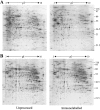Laser capture microdissection and two-dimensional polyacrylamide gel electrophoresis: evaluation of tissue preparation and sample limitations
- PMID: 11891180
- PMCID: PMC1867173
- DOI: 10.1016/S0002-9440(10)64904-8
Laser capture microdissection and two-dimensional polyacrylamide gel electrophoresis: evaluation of tissue preparation and sample limitations
Abstract
Laser capture microdissection (LCM) is now well established as a tool for facilitating the enrichment of cells of interest from tissue sections, overcoming the problem of tissue heterogeneity. LCM has been used extensively in combination with analysis at the DNA and RNA levels, but only a small number of studies have employed LCM with subsequent protein analysis, albeit with promising results. This study focuses on the potential of LCM in combination with two-dimensional polyacrylamide gel electrophoresis. The effects of tissue section preparation and sample type were evaluated to fully determine the suitability of using LCM in global protein profiling. The effects of several histochemical stains (hematoxylin and eosin, methyl green and toluidine blue) and immunolabeling on subsequent two-dimensional polyacrylamide gel electrophoresis were investigated. Quantitative analysis was performed to establish the extent of changes in the relative intensity of protein species and their reproducibility. All staining protocols tested were found to be compatible with protein analysis although there was variation in protein recovery and the quality of the protein profiles obtained. LCM of renal and cervix samples indicated that protein yield after dissection was acceptable, although the extent of enrichment and dissection time was tissue-dependent, which may preclude the use of this approach with some tissue types. These results indicate that LCM has potential as a tool in proteomic research.
Figures






Similar articles
-
Compatibility of toluidine blue with laser microdissection and saturation labeling DIGE.Proteomics. 2009 Jan;9(2):485-90. doi: 10.1002/pmic.200800197. Proteomics. 2009. PMID: 19086099
-
The potential use of laser capture microdissection to selectively obtain distinct populations of cells for proteomic analysis--preliminary findings.Electrophoresis. 1999 Apr-May;20(4-5):689-700. doi: 10.1002/(SICI)1522-2683(19990101)20:4/5<689::AID-ELPS689>3.0.CO;2-J. Electrophoresis. 1999. PMID: 10344234
-
Analysis of laser capture microdissected cells by 2-dimensional gel electrophoresis.Methods Mol Biol. 2008;428:77-91. doi: 10.1007/978-1-59745-117-8_5. Methods Mol Biol. 2008. PMID: 18287769
-
Laser capture microdissection and proteomics: possibilities and limitation.Proteomics. 2001 Oct;1(10):1200-4. doi: 10.1002/1615-9861(200110)1:10<1200::AID-PROT1200>3.0.CO;2-Q. Proteomics. 2001. PMID: 11721632 Review.
-
Laser capture microdissection: methodical aspects and applications with emphasis on immuno-laser capture microdissection.Pathobiology. 2000;68(4-5):209-14. doi: 10.1159/000055925. Pathobiology. 2000. PMID: 11279348 Review.
Cited by
-
The workflow from post-mortem human brain sampling to cell microdissection: a Brain Net Europe study.J Neural Transm (Vienna). 2015 Jul;122(7):975-91. doi: 10.1007/s00702-015-1378-4. Epub 2015 May 16. J Neural Transm (Vienna). 2015. PMID: 25976431
-
Proteomic analysis of prolactinoma cells by immuno-laser capture microdissection combined with online two-dimensional nano-scale liquid chromatography/mass spectrometry.Proteome Sci. 2010 Jan 29;8:2. doi: 10.1186/1477-5956-8-2. Proteome Sci. 2010. PMID: 20205839 Free PMC article.
-
Exosomal Proteome Profiling: A Potential Multi-Marker Cellular Phenotyping Tool to Characterize Hypoxia-Induced Radiation Resistance in Breast Cancer.Proteomes. 2013 Sep 1;1(2):87-108. doi: 10.3390/proteomes1020087. Proteomes. 2013. PMID: 24860738 Free PMC article.
-
Endometriosis research using capture microdissection techniques: Progress and future applications.Biomed Rep. 2016 Nov;5(5):531-540. doi: 10.3892/br.2016.758. Epub 2016 Sep 15. Biomed Rep. 2016. PMID: 27882213 Free PMC article.
-
Microproteomics: analysis of protein diversity in small samples.Mass Spectrom Rev. 2008 Jul-Aug;27(4):316-30. doi: 10.1002/mas.20161. Mass Spectrom Rev. 2008. PMID: 18271009 Free PMC article. Review.
References
-
- Reymond MA, Sanchez JC, Hughes GJ, Günther K, Riese J, Tortola S, Peinado MA, Kirchner T, Hohenberger W, Hochstrasser DF, Köckerling F: Standardized characterization of gene expression in human colorectal epithelium by two-dimensional electrophoresis. Electrophoresis 1997, 18:2842-2848 - PubMed
-
- Sarto C, Marocchi A, Sanchez JC, Giannone D, Frutiger S, Golaz O, Wilkins MR, Doro G, Cappellano F, Hughes G, Hochstrasser DF, Mocarelli P: Renal cell carcinoma and normal kidney protein expression. Electrophoresis 1997, 18:599-604 - PubMed
-
- Sirivatanauksorn Y, Drury R, Crnogorac-Jurcevic T, Sirivatanauksorn V, Lemoine NR: Laser-assisted microdissection: applications in molecular pathology. J Pathol 1999, 189:150-154 - PubMed
Publication types
MeSH terms
Substances
LinkOut - more resources
Full Text Sources
Other Literature Sources
Miscellaneous

